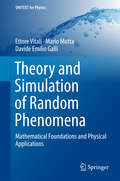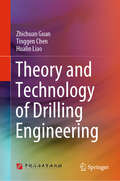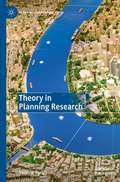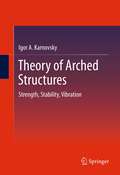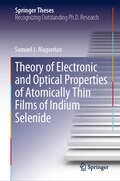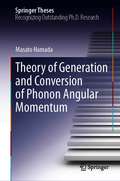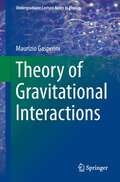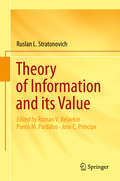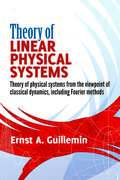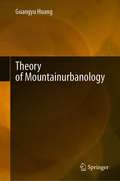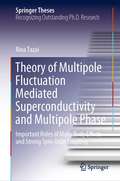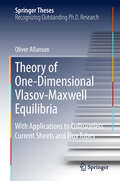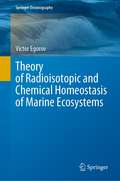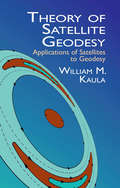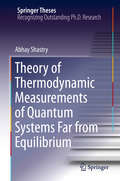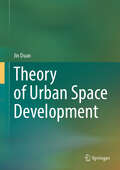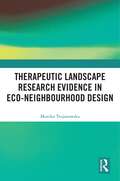- Table View
- List View
Theory and Simulation of Random Phenomena: Mathematical Foundations and Physical Applications (UNITEXT for Physics)
by Ettore Vitali Mario Motta Davide Emilio GalliThe purpose of this book is twofold: first, it sets out to equip the reader with a sound understanding of the foundations of probability theory and stochastic processes, offering step-by-step guidance from basic probability theory to advanced topics, such as stochastic differential equations, which typically are presented in textbooks that require a very strong mathematical background. Second, while leading the reader on this journey, it aims to impart the knowledge needed in order to develop algorithms that simulate realistic physical systems. Connections with several fields of pure and applied physics, from quantum mechanics to econophysics, are provided. Furthermore, the inclusion of fully solved exercises will enable the reader to learn quickly and to explore topics not covered in the main text. The book will appeal especially to graduate students wishing to learn how to simulate physical systems and to deepen their knowledge of the mathematical framework, which has very deep connections with modern quantum field theory.
Theory and Technology of Drilling Engineering
by Zhichuan Guan Tinggen Chen Hualin LiaoThis book presents the theory and technologies of drilling operations. It covers the gamut of formulas and calculations for petroleum engineers that have been compiled over several years. Some of these formulas and calculations have been used for decades, while others help guide engineers through some of the industry’s more recent technological breakthroughs. Comprehensively discussing all aspects of drilling technologies, and providing abundant figures, illustrations and tables, examples and exercises to facilitate the learning process, it is a valuable resource for students, scholars and engineers in the field of petroleum engineering.
Theory in Planning Research (Planning, Environment, Cities)
by Yvonne RydinDoing research is an essential element of almost all programmes in planning studies as well as related areas such as geography and urban studies, from undergraduate, through Masters to doctoral programmes. While most texts on such research emphasise methodologies, this book is unique in addressing how theoretical frameworks and perspectives can inform research activity. Providing both a concise introduction to a wide range of such theories and detailed engagement with cases of planning research, it provides the reader with the insights necessary to conduct theory-informed research. It offers an understanding of how the choice of a theoretical framework has implications for the focus of the research, the precise research questions addressed and the methodologies that will be most effective in answering those questions. Through practical advice and published examples it will support planning researchers in doing stronger, more widely-applicable research, which answers key questions about planning systems and their role within our societies.
Theory of Arched Structures
by Igor A KarnovskyTheory of Arched Structures: Strength, Stability, Vibration presents detailed procedures for analytical analysis of the strength, stability, and vibration of arched structures of different types, using exact analytical methods of classical structural analysis. The material discussed is divided into four parts. Part I covers stress and strain with a particular emphasis on analysis; Part II discusses stability and gives an in-depth analysis of elastic stability of arches and the role that matrix methods play in the stability of the arches; Part III presents a comprehensive tutorial on dynamics and free vibration of arches, and forced vibration of arches; and Part IV offers a section on special topics which contains a unique discussion of plastic analysis of arches and the optimal design of arches..
Theory of Electronic and Optical Properties of Atomically Thin Films of Indium Selenide (Springer Theses)
by Samuel J. MagorrianThis thesis provides the first comprehensive theoretical overview of the electronic and optical properties of two dimensional (2D) Indium Selenide: atomically thin films of InSe ranging from monolayers to few layers in thickness. The thesis shows how the electronic propertes of 2D InSe vary significantly with film thickness, changing from a weakly indirect semiconductor for the monolayer to a direct gap material in the bulk form, with a strong band gap variation with film thickness predicted and recently observed in optical experiments. The proposed theory is based on a specially designed hybrid k.p tight-binding model approach (HkpTB), which uses an intralayer k.p Hamiltonian to describe the InSe monolayer, and tight-binding-like interlayer hopping. Electronic and optical absorption spectra are determined, and a detailed description of subbands of electrons in few-layer films and the influence of spin-orbit coupling is provided. The author shows that the principal optical excitations of InSe films with the thickness from 1 to 15 layers broadly cover the visible spectrum, with the possibility of extending optical functionality into the infrared and THz range using intersubband transitions.
Theory of Fermi-liquids in Metals: A Compact Overview as an Introduction to Theoretical Solid-State Physics (essentials)
by Michael KinzaThis essential offers a compact introduction to the theory of Fermi liquid for physics students in their main studies. It forms the basis for an understanding of theoretical solid state physics and is part of every introductory lecture on this topic. After a brief overview of the Sommerfeld model of metals, the concept of the quasiparticle is introduced. Important calculations characterizing a Fermi liquid are derived in detailed calculations. The essential concludes with an overview of the microscopic theory of Fermi liquids.This Springer essential is a translation of the original German 1st edition essentials, Theorie der Fermiflüssigkeit in Metallen by Michael Kinza, published by Springer Fachmedien Wiesbaden GmbH, part of Springer Nature in 2018. The translation was done with the help of artificial intelligence (machine translation by the service DeepL.com). A subsequent human revision was done primarily in terms of content, so that the book will read stylistically differently from a conventional translation. Springer Nature works continuously to further the development of tools for the production of books and on the related technologies to support the authors.
Theory of Generation and Conversion of Phonon Angular Momentum (Springer Theses)
by Masato HamadaThis book presents a theoretical study of the generation and conversion of phonon angular momentum in crystals.Recently, rotational motions of lattice vibrations, i.e., phonons, in crystals attract considerable attentions. As such, the book theoretically demonstrate generations of phonons with rotational motions, based on model calculations and first-principle calculations. In systems without inversion symmetry, the phonon angular momentum is shown to be caused by the temperature gradient, which is demonstrated in crystals such as wurtzite gallium nitride, tellurium, and selenium using the first-principle calculations. In systems with neither time-reversal nor inversion symmetries, the phonon angular momentum is shown to be generated by an electric field. Secondly, the book presents the microscopic mechanisms developed by the author and his collaborator on how these microscopic rotations of nuclei are coupled with electron spins. These predictions serve as building blocks for spintronics with phonons or mechanical motions.
Theory of Gravitational Interactions
by Maurizio GasperiniThis reference textbook is an up-to-date and self-contained introduction to the theory of gravitational interactions. The first part of the book follows the traditional presentation of general relativity as a geometric theory of the macroscopic gravitational field. A second, advanced part then discusses the deep analogies (and differences) between a geometric theory of gravity and the gauge theories of the other fundamental interactions. This fills a gap which is present in the context of the traditional approach to general relativity, and which usually makes students puzzled about the role of gravity. The necessary notions of differential geometry are reduced to the minimum, leaving more room for those aspects of gravitational physics of current phenomenological and theoretical interest, such as the properties of gravitational waves, the gravitational interactions of spinors, and the supersymmetric generalization of the Einstein equations. Theory of Gravitational Interactions will be of particular value to undergraduate students pursuing a theoretical or astroparticle curriculum. It can also be used by those teaching related subjects, by PhD students and young researchers working in different scientific sectors but wishing to enlarge their spectrum of interests, and, in general, by all scholars interested in the modern aspects and problems of gravitational interaction.
Theory of Gyroscopic Effects for Rotating Objects: Gyroscopic Effects and Applications
by Ryspek UsubamatovThis book highlights an analytical solution for the dynamics of axially rotating objects. It also presents the theory of gyroscopic effects, explaining their physics and using mathematical models of Euler’s form for the motion of movable spinning objects to demonstrate these effects. The major themes and approaches are represented by the spinning disc and the action of the system of interrelated inertial torques generated by the centrifugal and Coriolis forces, as well as the change in the angular momentum. The interrelation of inertial torques is based on the dependency of the angular velocities of the motions of the spinning objects around axes by the principle of mechanical energy conservation. These kinetically interrelated torques constitute the fundamental principles of the mechanical gyroscope theory that can be used for any rotating objects of different designs, like rings, cones, spheres, paraboloids, propellers, etc. Lastly, the mathematical models for the gyroscopic effects are validated by practical tests. The 2nd edition became necessary due to new development and corrections of mathematical expressions: It contains new chapters about the Tippe top inversion and inversion of the spinning object in an orbital flight and the boomerang aerodynamics.
Theory of Gyroscopic Effects for Rotating Objects: Gyroscopic Effects and Applications
by Ryspek UsubamatovThis book highlights an analytical solution for the dynamics of axially rotating objects. It also presents the theory of gyroscopic effects, explaining their physics and using mathematical models of Euler’s form for the motion of movable spinning objects to demonstrate these effects. The major themes and approaches are represented by the spinning disc and the action of the system of interrelated inertial torques generated by the centrifugal and Coriolis forces, as well as the change in the angular momentum. The interrelation of inertial torques is based on the dependency of the angular velocities of the motions of the spinning objects around axes by the principle of mechanical energy conservation. These kinetically interrelated torques constitute the fundamental principles of the mechanical gyroscope theory that can be used for any rotating objects of different designs, like rings, cones, spheres, paraboloids, propellers, etc. Lastly, the mathematical models for the gyroscopic effects are validated by practical tests. This book is highlighted in its already third edition. The new edition comprises many new sections for several chapters or new chapters. The most important ones are: Chapter 3 includes a mathematical model for the section inertia torques acting on the spinning annulus and thin ring. The latter does not have a full solution because the handbooks comprise simplified parameters that cannot be used for an exact solution. Chapter 4 offers mathematical model for the arbitrary disposition of the spinning object in space that shows the action of the additional four inertial torques acting on the third axis and new dependencies of gyroscope motions. Chapter 7 now presents mathematical model for the gyroscope nutation with a full solution. The known mathematical model presents a partial solution due to the complexity of the problem.
Theory of Information and its Value
by Ruslan L. StratonovichThis English version of Ruslan L. Stratonovich’s Theory of Information (1975) builds on theory and provides methods, techniques, and concepts toward utilizing critical applications. Unifying theories of information, optimization, and statistical physics, the value of information theory has gained recognition in data science, machine learning, and artificial intelligence. With the emergence of a data-driven economy, progress in machine learning, artificial intelligence algorithms, and increased computational resources, the need for comprehending information is essential. This book is even more relevant today than when it was first published in 1975. It extends the classic work of R.L. Stratonovich, one of the original developers of the symmetrized version of stochastic calculus and filtering theory, to name just two topics.Each chapter begins with basic, fundamental ideas, supported by clear examples; the material then advances to great detail and depth. The reader is not required to be familiar with the more difficult and specific material. Rather, the treasure trove of examples of stochastic processes and problems makes this book accessible to a wide readership of researchers, postgraduates, and undergraduate students in mathematics, engineering, physics and computer science who are specializing in information theory, data analysis, or machine learning.
Theory of Linear Physical Systems: Theory of physical systems from the viewpoint of classical dynamics, including Fourier methods
by Ernst A. GuilleminAn eminent electrical engineer and authority on linear system theory takes upper-level undergraduates and graduate students beyond the average introductory circuits course, providing them with additional background for understanding advanced network synthesis. This sophisticated treatise broadens students' understanding of the topological and algebraic relations for establishing equilibrium equations and transformations between sets of variables. The text further examines energy functions in both active and passive situations as well as important properties of impedance and similar characterizing functions.The treatment also explores the evaluation and prediction of approximation and truncation errors attendant upon the use of numerical methods of direct and inverse Fourier transform evaluation; the properties of partial sums; and the interpretation of limit processes. In addition, the text stresses the relation between the Fourier and Laplace methods and the approach in classical dynamics, basing the evaluation of Fourier integrals upon meaningful physical reasoning and providing an effective tool for dealing with special problems from the viewpoint of classical dynamics.
Theory of Liquids: From Excitations to Thermodynamics
by Kostya TrachenkoOf the three basic states of matter, liquid is perhaps the most complex. While its flow properties are described by fluid mechanics, its thermodynamic properties are often neglected, and for many years it was widely believed that a general theory of liquid thermodynamics was unattainable. In recent decades that view has been challenged, as new advances have finally enabled us to understand and describe the thermodynamic properties of liquids. This book explains the recent developments in theory, experiment and modelling that have enabled us to understand the behaviour of excitations in liquids and the impact of this behaviour on heat capacity and other basic properties. Presented in plain language with a focus on real liquids and their experimental properties, this book is a useful reference text for researchers and graduate students in condensed matter physics and chemistry as well as for advanced courses covering the theory of liquids.
Theory of Mountainurbanology
by Guangyu HuangThis book is about mountainurbanology grounded in Southwest China, where mountain is a typical landform for many towns and cities. From the multi-disciplinary perspective in a dynamic changing context, it presents a comprehensive framework including the location of mountain city, planning, design, building, transportation, disaster, aesthetics and governance in building up mountain cities based on investigation of natural, social and economic studies. The book also emphasizes ecological planning method based on topography in mountainous area through the lens of teaching and practice on urban planning for over half a century in Southwest China. It is a highly informative book providing academic insight for senior undergraduates, graduate students, lecturers, research professionals and decision makers with an interest in urban planning, ecology, planning and design in mountainous region development. Prof. Guangyu Huang is regarded as Founding Pioneer of mountainurbanology in China, a sub-discipline of urban planning.
Theory of Multipole Fluctuation Mediated Superconductivity and Multipole Phase: Important Roles of Many Body Effects and Strong Spin-Orbit Coupling (Springer Theses)
by Rina TazaiA strong spin-orbit interaction and Coulomb repulsion featuring strongly correlated d- and f-electron systems lead to various exotic phase transition including unconventional superconductivity and magnetic multipole order. However, their microscopic origins are long standing problem since they could not be explained based on conventional Migdal-Eliashberg theorem. The book focuses on many-body correlation effects beyond conventional theory for the d- and f-electron systems, and theoretically demonstrates the correlations to play significant roles in “mode-coupling” among multiple quantum fluctuations, which is called U-VC here. The following key findings are described in-depth: (i) spin triplet superconductivity caused by U-VC, (ii) being more important U-VC in f-electron systems due to magnetic multipole degrees of freedom induced by a spin-orbit interaction, and (iii) s-wave superconductivity stabilized cooperatively by antiferromagnetic fluctuations and electron-phonon interaction contrary to conventional understanding. The book provides meaningful step for revealing essential roles of many-body effects behind long standing problems in strongly correlated materials.
Theory of One-Dimensional Vlasov-Maxwell Equilibria: With Applications To Collisionless Current Sheets And Flux Tubes (Springer Theses)
by Oliver AllansonThis book describes and contextualises collisionless plasma theory, and in particular collisionless plasma equilibria. The Vlasov–Maxwell theory of collisionless plasmas is an increasingly important tool for modern plasma physics research: our ability to sustain plasma in a steady-state, and to mitigate instabilities, determines the success of thermonuclear fusion power plants on Earth; and our understanding of plasma aids in the prediction and mitigation of Space Weather effects on terrestrial environments and satellites. Further afield, magnetic reconnection is a ubiquitous energy release mechanism throughout the Universe, and modern satellites are now able to make in-situ measurements with kinetic scale resolution. To keep pace with these challenges and technological developments, a modern scientific discussion of plasma physics must enhance, and exploit, its ‘literacy’ in kinetic theory. For example, accurate analytical calculations and computer simulations of kinetic instabilities are predicated on a knowledge of Vlasov–Maxwell equilibria as an initial condition. This book highlights new fundamental work on Vlasov–Maxwell equilibria, of potential interest to mathematicians and physicists alike. Possible applications involve two of the most significant magnetic structures known to confine plasma and store energy: current sheets and flux tubes.
Theory of Phase Transitions in Polypeptides and Proteins
by Alexander V. YakubovichThere are nearly 100 000 different protein sequences encoded in the human genome, each with its own specific fold. Understanding how a newly formed polypeptide sequence finds its way to the correct fold is one of the greatest challenges in the modern structural biology. The aim of this thesis is to provide novel insights into protein folding by considering the problem from the point of view of statistical mechanics. The thesis starts by investigating the fundamental degrees of freedom in polypeptides that are responsible for the conformational transitions. This knowledge is then applied in the statistical mechanics description of helix coil transitions in polypeptides. Finally, the theoretical formalism is generalized to the case of proteins in an aqueous environment. The major novelty of this work lies in combining (a) a formalism based on fundamental physical properties of the system and (b) the resulting possibility of describing the folding unfolding transitions quantitatively. The clear physical nature of the formalism opens the way to further applications in a large variety of systems and processes.
Theory of Radioisotopic and Chemical Homeostasis of Marine Ecosystems (Springer Oceanography)
by Victor EgorovThe book is dedicated to the study and mathematical definition of the biogeochemical patterns of organic and inorganic matter interaction with the marine environment's radioactive and chemical components. This book describes the radioisotope and mineral exchange theory between organic and inorganic matters in the marine environment on a time scale of metabolic processes and trophic interactions. The approach is parametrically compatible with modern techniques describing the matter and energy balance in aquatic ecosystems. The criteria for assessing the ecological capacity, biogeocenoses assimilation capacity, and water masses radio capacity, which form the basis of the theory of radioisotope and mineral homeostasis of marine ecosystems, are substantiated. This book presents methods to implement sustainable development of the Black Sea's critical and recreational zones according to the marine pollution factors. This book does that by regulating the balance between the consumption of water quality resources and their reproduction as a result of natural biogeochemical processes are proposed. The book is of interest to scientists working in marine geology, marine ecology, biogeophysics, and biogeochemistry. This book is also necessary for professionals working in institutions and administrations coordinating maritime activities, environmental projects, and developing aquaculture technologies.
Theory of Satellite Geodesy: Applications of Satellites to Geodesy (Dover Earth Science)
by William M. KaulaThe main purpose of this classic text is to demonstrate how Newtonian gravitational theory and Euclidean geometry can be used and developed in the earth's environment. The second is to collect and explain some of the mathematical techniques developed for measuring the earth by satellite.Book chapters include discussions of the earth's gravitational field, with special emphasis on spherical harmonies and the potential of the ellipsoid; matrices and orbital geometry; elliptic motion, linear perturbations, resonance, and other aspects of satellite orbit dynamics; the geometry of satellite observations, including time and precise definition of coordinates, and observability conditions; and statistical implications and date analysis.The completion of a first-year course in physics and a first-year course in calculus is assumed.
Theory of Spinors and Its Application in Physics and Mechanics
by Vladimir A. ZhelnorovichThis book contains a systematic exposition of the theory of spinors in finite-dimensional Euclidean and Riemannian spaces. The applications of spinors in field theory and relativistic mechanics of continuous media are considered. The main mathematical part is connected with the study of invariant algebraic and geometric relations between spinors and tensors. The theory of spinors and the methods of the tensor representation of spinors and spinor equations are thoroughly expounded in four-dimensional and three-dimensional spaces. Very useful and important relations are derived that express the derivatives of the spinor fields in terms of the derivatives of various tensor fields.The problems associated with an invariant description of spinors as objects that do not depend on the choice of a coordinate system are addressed in detail. As an application, the author considers an invariant tensor formulation of certain classes of differential spinor equations containing, in particular, the most important spinor equations of field theory and quantum mechanics. Exact solutions of the Einstein–Dirac equations, nonlinear Heisenberg’s spinor equations, and equations for relativistic spin fluids are given. The book presents a large body of factual material and is suited for use as a handbook. It is intended for specialists in theoretical physics, as well as for students and post-graduate students of physical and mathematical specialties.
Theory of Thermodynamic Measurements of Quantum Systems Far from Equilibrium (Springer Theses)
by Abhay ShastryThis thesis presents several related advances in the field of nonequilibrium quantum thermodynamics. The central result is an ingenious proof that the local temperature and voltage measurement in a nonequilibrium system of fermions exists and is unique, placing the concept of local temperature on a rigorous mathematical footing for the first time. As an intermediate step, a proof of the positivity of the Onsager matrix of linear response theory is given -- a statement of the second law of thermodynamics that had lacked an independent proof for 85 years. A new experimental method to measure the local temperature of an electron system using purely electrical techniques is also proposed, which could enable improvements to the spatial resolution of thermometry by several orders of magnitude. Finally, a new mathematically-exact definition for the local entropy of a quantum system in a nonequilibrium steady state is derived. Several different measures of the local entropy are discussed, relating to the thermodynamics of processes that a local observer with varying degrees of information about the microstates of the system could carry out, and it is shown that they satisfy a hierarchy of inequalities. Proofs of the third law of thermodynamics for generic open quantum systems are presented, taking into account the entropic contribution due to localized states. Appropriately normalized (per-state) local entropies are defined and are used to quantify the departure from local equilibrium.
Theory of Urban Space Development
by Jin DuanThis book is a systematic monograph on urban space development theory, exploring the laws of urban space development and the basic principles of planning and design. It clarifies the connotation and methods of urban space development research, highlights the deep structure and four laws of urban space development, expounds the obvious characteristics of urban and regional forms, and discusses the interventional role of urban planning and the development mode of Chinese urban space. It also discusses the methodological change of modern urban design, and forms the principles and core content of China's national spatial planning. Guided by the fundamental principles and methods of development theory, this book follows logical progression from concept to method, from deep structure to manifest form, from macro to micro and from law to planning. By providing readers with a comprehensive and systematic urban space development research system, this book is a valuable read for both researchers and graduate students in urban studies and architectural design. The translation was done with the help of artificial intelligence. A subsequent human revision was done primarily in terms of content.
Theory of the Nuclear Magnetic 1/T1 Relaxation Rate in Conventional and Unconventional Magnets
by Andrew SmeraldOne of the best ways to "lift the lid" on what is happening inside a given material is to study it using nuclear magnetic resonance (NMR). Of particular interest are NMR 1/T1 relaxation rates, which measure how fast energy stored in magnetic nuclei is transferred to surrounding electrons. This thesis develops a detailed, quantitative theory of NMR 1/T1 relaxation rates, and shows for the first time how they could be used to measure the speed at which energy travels in a wide range of magnetic materials. This theory is used to make predictions for"Quantum Spin Nematics", an exotic form of quantum order analogous to a liquid crystal. In order to do so, it is first necessary to unravel how spin nematics transport energy. This thesis proposes a new way to do this, based on the description of quarks in high-energy physics. Experiments to test the ideas presented are now underway in laboratories across the world.
Theory of the Spread of Epidemics and Movement Ecology of Animals: An Interdisciplinary Approach using Methodologies of Physics and Mathematics
by V. M. Kenkre Luca GiuggioliExploiting powerful techniques from physics and mathematics, this book studies animal movement in ecology, with a focus on epidemic spread. Pulmonary syndrome is not only feared in epidemics of recent times, such as COVID-19, but is also characteristic of epidemics studied earlier such as Hantavirus. The Hantavirus is one of the book's central topics. Correlations between epidemic outbreaks and precipitation events like El Niño are analyzed and spatial reservoirs of infection in off-period of the epidemic, known as refugia, are studied. Predicted traveling waves of infection are successfully compared to field observations. Territoriality in scent-marking animals is presented, with parallels drawn with the theory of melting. The flocking and herding of birds and mammals are described in terms of collective excitations. For scientists interested in movement ecology and epidemic spread, this book provides effective solutions to long-standing problems.
Therapeutic Landscape Research Evidence in Eco-neighbourhood Design
by Monika TrojanowskaThis book presents how to recreate therapeutic landscapes in everyday places of eco-neighbourhoods. The concept of eco-neighbourhoods goes beyond the traditional form of a residential district. Eco-neighbourhoods are characterized by many aspects related to sustainability, including protection of the environment, building social capital, ensuring a high quality of life with low economic costs, and promoting social and environmental justice. The presented work aims to systematize these phenomena and interpret them.The action to take care of our common home, the Earth, starts locally. Creating townscapes that can promote everyday health could improve the standards of living on our planet. In both hemispheres, the majority of people live in cities; therefore, examples of good practices described in this book come from all inhabited continents. Education is the most empowering tool, which can change the future for many. Implementing eco-neighbourhoods may bring well-deserved change and hope to people in less-favoured locations of the globe.This book will be of interest to practitioners and students of architecture, civil and environmental engineering, landscape design, spatial management, urban planning, and related fields.
